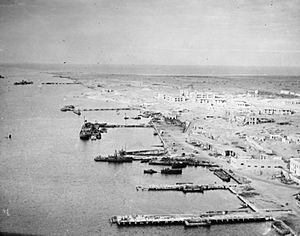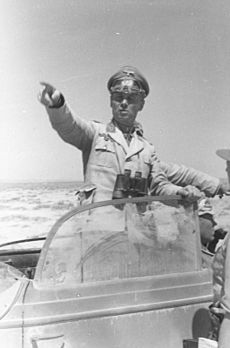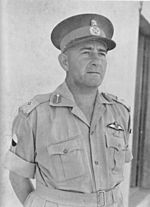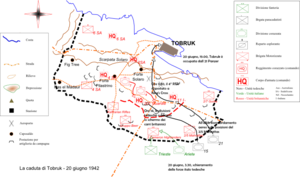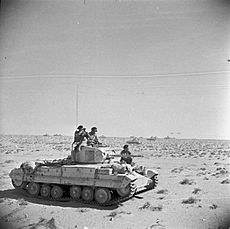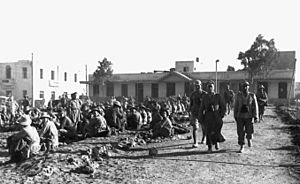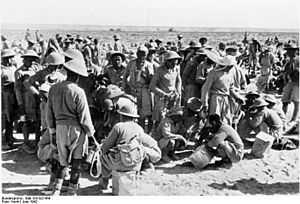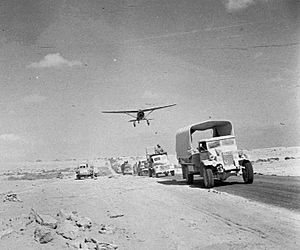Axis capture of Tobruk facts for kids
Quick facts for kids Axis capture of Tobruk |
|||||||
|---|---|---|---|---|---|---|---|
| Part of the Western Desert campaign of the Second World War | |||||||
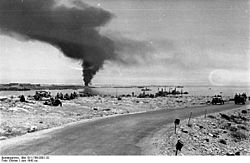 The road from Bardia to Tobruk on 21 June 1942 with British prisoners of war on the left, sunken ships in the harbour and smoke over the port. |
|||||||
|
|||||||
| Belligerents | |||||||
| Commanders and leaders | |||||||
| Ettore Bastico Erwin Rommel |
Claude Auchinleck Neil Ritchie Hendrik Klopper |
||||||
| Strength | |||||||
| Deutsches Afrika Korps X Corpo d'Armata XXI Corpo d'Armata |
35,000 troops | ||||||
| Casualties and losses | |||||||
| c. 3,360 | 33,000 taken prisoner | ||||||
The Axis capture of Tobruk, also known as the Fall of Tobruk or the Second Battle of Tobruk, happened from June 17 to 21, 1942. It was a key part of the Western Desert campaign in Libya during the Second World War.
This battle involved the Panzerarmee Afrika (also called the Armored Army Africa). This was a strong German-Italian army led by Erwin Rommel. They fought against the British Eighth Army, which included soldiers from Britain, India, South Africa, and other Allied countries.
Tobruk was a very important port city. It had been under siege for eight months in 1941. Its defenders became a symbol of courage. But by mid-1942, the British decided not to defend it the same way again. Many of its defenses had been moved to other battle lines. Also, most of the British air force had moved too far away to help.
The British Eighth Army had just lost the Battle of Gazala. This forced them to retreat, leaving Tobruk alone. The British Prime Minister, Winston Churchill, really wanted to hold Tobruk. But there was confusion about whether to defend it or leave. In the end, the city was surrounded.
On June 20, the German-Italian forces attacked Tobruk with huge air support. They broke through the defenses and quickly captured the port. Many British soldiers were cut off and had to surrender. About 33,000 prisoners were taken.
This surrender was one of the biggest defeats for the British Army in the war. It caused a big political problem in Britain. The United States quickly sent more supplies to the Middle East. Rommel used the captured supplies to push further into Egypt. This caused the planned invasion of Malta to be delayed. The Axis advance eventually stopped at the First Battle of Alamein in July 1942.
Contents
Why Tobruk Was Important
Tobruk was a small port in Italian Cyrenaica, a region in Libya. The Italians had built strong defenses there since 1935. These included long trenches and hidden anti-tank ditches.
In January 1941, Australian forces captured Tobruk. This happened during Operation Compass, an early Allied operation. Later, German forces arrived, led by Erwin Rommel. They took back much of the land. Tobruk was then cut off and surrounded from April to December 1941.
The Allies used the Italian defenses to hold off Axis attacks. Tobruk was important because it threatened Axis supply lines. It also stopped them from using the port. Its defense became a symbol of British strength. The Allies tried to relieve Tobruk several times, but failed. Finally, Operation Crusader in late 1941 ended the siege.
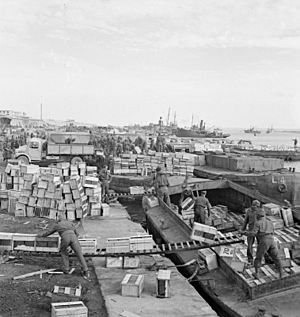
After this, the Axis forces launched another attack. They took back western Cyrenaica. Both sides then prepared for a new fight. The British built the Gazala Line, which had strong positions and many minefields. But the Axis attacked first with the Battle of Gazala on May 26, 1942. The British tanks were not as good, and their forces were not well-coordinated. Rommel defeated the British Eighth Army. By June 13, the British were retreating, leaving Tobruk open to attack.
Axis Plans for Tobruk
On May 1, 1942, top Axis leaders met. They decided that Rommel should attack Tobruk. If he succeeded, he was supposed to stop at the Egyptian border. The plan was to invade Malta next, which would secure supply lines. After Malta, Rommel would invade Egypt to capture the Suez Canal.
The Axis had a big advantage. They had broken a secret code used by a US military officer. This allowed them to read detailed reports about the British forces.
British Plans for Tobruk
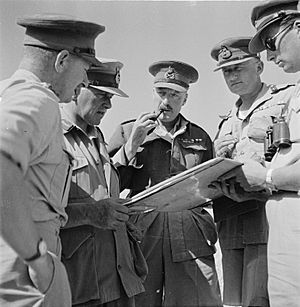
In February 1942, British commanders discussed what to do if the Axis attacked again. They knew Tobruk was valuable to the Axis. But they decided not to defend it like a fortress. General Claude Auchinleck did not want to tie down a whole division there. Also, supplying the city by sea was too risky.
The British commander, Lieutenant-General Neil Ritchie, was told to try and stop Tobruk from being taken. But he was also told not to let his forces get surrounded. If Tobruk was about to fall, he should evacuate his troops and destroy everything useful. This plan was called Operation Freeborn.
By June 14, the British were forced to use Operation Freeborn. They began pulling troops back through Tobruk towards Egypt. However, Prime Minister Churchill sent a message saying that "retreat would be fatal." This caused confusion. Auchinleck then told Ritchie to hold a line west of Tobruk. But Ritchie's troops were already moving.
The situation became very confusing. Churchill kept sending messages that seemed to say Tobruk must be held. Auchinleck then told Ritchie that Tobruk could be "isolated for short periods" but not "invested" (surrounded). Ritchie realized the defenses were about to collapse.
Tobruk Becomes Isolated
On June 15, German forces attacked British positions near Tobruk. They were pushed back at first. But later, they broke through. This forced the British air force to move further east, reducing air support for Tobruk.
On June 17, a British armored brigade tried to counter-attack but lost many tanks. The Germans reached the coast, cutting off Tobruk. Rommel reported on June 18 that Tobruk was surrounded.
Who Fought at Tobruk
Tobruk's Defenders
The Tobruk garrison had about 33,000 men. But many were support staff, not fighting troops. About a third were from the 2nd South African Infantry Division, led by Major General Hendrik Klopper. He took command of Tobruk's defense on June 15.
The British also had tank units with Valentine tanks and Matildas. There were also British and Indian infantry brigades. The garrison had various artillery units, including anti-tank and anti-aircraft guns.
Many non-essential troops had been evacuated. The airfields inside the perimeter were no longer used by fighters. The defenses around Tobruk were not in good shape. Trenches had collapsed, and minefields had been removed to help other battle lines. Some old Italian mines were also faulty.
Klopper was given command only five days before the Axis attack. He was also asked to prepare several complex plans. This added a lot of pressure on him and his staff.
Axis Attacking Forces
Rommel planned to attack Tobruk from the south-east. This area had flatter ground. He started moving his forces into position on June 18.
The Axis forces included Italian corps and German divisions. The German 15th Panzer Division and 21st Panzer Division were key to the attack. The Axis also had about 150 bombers and 150 fighters ready to support the attack. They could refuel quickly at recently captured airfields.
The Battle for Tobruk
June 18–19: Getting Ready
Rommel wanted to attack quickly. On June 18, he gave his orders. German armored units moved to face the south-eastern part of Tobruk's defenses. This area was held by less experienced Indian troops.
June 20: The Main Attack
Morning Attack
The attack began at 5:20 a.m. on June 20 with a huge air bombardment. German planes flew 588 missions, dropping over 365 tons of bombs. Italian planes also flew many missions.
German infantry and engineers attacked at 7:00 a.m. They quickly made a gap in the defenses. By 8:30 a.m., the first German tanks were inside the perimeter. They created a wide opening. The Indian defenders tried to counter-attack but failed.
Klopper ordered a counter-attack by British tanks. But there was a misunderstanding, and only a small force attacked. This attack might have worked if it had been stronger. But by then, the German tanks were already well inside. The German air force also constantly attacked the British tanks.
Noon and Evening
By noon, Rommel had 113 tanks inside Tobruk. By 1:30 p.m., the German forces reached a key road junction overlooking the town. The 21st Panzer Division headed for Tobruk, scattering the remaining British tanks. British artillery units put up a strong fight, even using anti-aircraft guns against tanks. Rommel praised their toughness.
Later in the afternoon, Klopper's headquarters was attacked. He ordered a quick evacuation, destroying much of their communication gear. Without communications, Klopper moved to another headquarters.
By 6:00 p.m., German units reached the edge of the port. British engineers began destroying huge amounts of fuel, water, and supplies in the town. They also destroyed port facilities. Some British naval vessels escaped, but many were sunk.
At nightfall, the Axis forces stopped. The remaining British and Indian units prepared to defend themselves. The South African brigades in the west had not been heavily attacked. Klopper ordered all units to try to break out at 10:00 p.m. He sent a message to the Eighth Army, saying, "Am holding out but I do not know for how long."
The Eighth Army suggested breaking out the next night and destroying all fuel. Klopper discussed the situation with his officers. A breakout was difficult because many vehicles had been captured. The main ammunition dumps were also captured. At 2:00 a.m. on June 21, Klopper signaled that he would try to break out that evening. Until then, the garrison would "fight to the last man and the last round."
June 21: The Surrender
As dawn approached, Klopper changed his mind. He decided that continuing to fight would cause too many casualties. At 6:00 a.m., Ritchie sent a message saying, "I cannot tell tactical situation and therefore leave you to act on your own judgement regarding capitulation."
Soon after, German officers came to Klopper's headquarters to arrange the surrender. Orders to surrender were sent out. Some units, who had barely fought, were surprised. A few units did not get the order and kept fighting. The 2nd Battalion, 7th Gurkha Rifles, fought until that evening. The Cameron Highlanders fought until the morning of June 22.
A small group of British and South African soldiers managed to break out and escape. Rommel entered Tobruk at 5:00 a.m. and set up his headquarters. He met Klopper at 9:40 a.m. on June 21, and Klopper formally surrendered.
What Happened Next
Prisoners and Losses
| Nationality | POW |
|---|---|
| British | 19,000 |
| South African | 10,720 |
| Indian | 2,500 |
| Total | 32,200 |
The surrender of Tobruk was a huge defeat for the British Army. It was the second largest surrender after the fall of Singapore. German reports first said 25,000 Allied prisoners were taken, but the real number was 32,200.
The Germans left the prisoners to the Italians. The Italians did not have enough resources to care for them properly. Conditions were tough, with little food or water. Many prisoners, especially South Africans, faced criticism from others who felt Tobruk surrendered too easily.
Axis casualties are not fully known. But German losses for the fighting since May 26 (including Gazala) were about 3,360.
Axis Gains
The capture of Tobruk was a huge propaganda victory for Germany. On June 22, Hitler promoted Rommel to Field Marshal, making him the youngest in the German Army. Mussolini was also very happy.
Despite the British destroying some supplies, the Axis captured a lot. This included thousands of tons of fuel, water, and food. They also took about 2,000 vehicles, including 30 tanks. Rommel used many of these captured British trucks. The captured supplies were a great help to the Axis troops, who had been on very short rations.
On June 21, a German commander reminded Rommel about the plan to invade Malta. But Rommel, now a field marshal, decided to keep pushing into Egypt. He had secret reports that said the British forces were disorganized. The captured supplies from Tobruk made the push into Egypt possible.
Axis Invasion of Egypt
On June 22, Rommel asked Mussolini directly to let him continue the attack into Egypt. He also asked to postpone the Malta invasion to keep his air support. Mussolini agreed.
The British retreat became a fast escape. Ritchie decided not to regroup at the Egyptian border. Instead, he pulled back further east to Mersa Matruh. On June 25, Auchinleck fired Ritchie and took command of the Eighth Army himself. He ordered another retreat to a better defensive position at El Alamein.
On June 26, Rommel broke through at Mersa Matruh. This was another defeat for the Eighth Army, who lost many soldiers and equipment. But most of the Eighth Army managed to escape to El Alamein. Rommel hoped to attack the new British positions quickly. However, he was moving further from his air support and supply bases. The British air force could now reach him easily. The Axis advance was finally stopped at the First Battle of El Alamein. This was the furthest east the Axis forces ever reached in North Africa.
See also
- List of British military equipment of World War II
- List of German military equipment of World War II
- List of Italian military equipment in World War II


